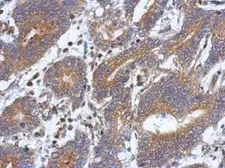APPLICATION
Application Note
*Optimal dilutions/concentrations should be determined by the researcher.
| Application |
Recommended Dilution |
| 1:500-1:3000 |
| 1:100-1:1000 |
Not tested in other applications.
Calculated MW
Positive Control
293T , A431 , HeLa , HepG2 , U87-MG , SK-N-SH , IMR32 , SK-N-AS
Predict Reactivity
Mouse, Rat, Bovine, Chimpanzee, Rhesus Monkey(>80% identity)
PROPERTIES
Form
Liquid
Buffer
PBS, 1% BSA, 20% Glycerol
Preservative
0.01% Thimerosal
Storage
Store as concentrated solution. Centrifuge briefly prior to opening vial. For short-term storage (1-2 weeks), store at 4ºC. For long-term storage, aliquot and store at -20ºC or below. Avoid multiple freeze-thaw cycles.
Concentration
0.78 mg/ml (Please refer to the vial label for the specific concentration.)
Antigen Species
Human
Immunogen
Recombinant protein encompassing a sequence within the center region of human ATXN10. The exact sequence is proprietary.
Purification
Purified by antigen-affinity chromatography.
Conjugation
Unconjugated
RRID
AB_11168461
Note
For laboratory research use only. Not for any clinical, therapeutic, or diagnostic use in humans or animals. Not for animal or human consumption.
Purchasers shall not, and agree not to enable third parties to, analyze, copy, reverse engineer or otherwise attempt to determine the structure or sequence of the product.
TARGET
Synonyms
ataxin 10 , E46L , HUMEEP , SCA10
Background
The autosomal dominant cerebellar ataxias (ADCAs) are a clinically and genetically heterogeneous group of disorders characterized by ataxia, dysarthria, dysmetria, and intention tremor. All ADCAs involve some degree of cerebellar dysfunction and a varying degree of signs from other components of the nervous system. A commonly accepted clinical classification (Harding, 1993) divides ADCAs into 3 different groups based on the presence or absence of associated symptoms such as brainstem signs or retinopathy. The presence of pyramidal and extrapyramidal symptoms and ophthalmoplegia makes the diagnosis of ADCA I, the presence of retinopathy points to ADCA II, and the absence of associated signs to ADCA III. Genetic linkage and molecular analyses revealed that ADCAs are genetically heterogeneous even within the various subtypes.[supplied by OMIM]
Database
Research Area
DATA IMAGES

|
GTX105440 IHC-P Image
Immunohistochemical analysis of paraffin-embedded human colon carcinoma, using ATXN10(GTX105440) antibody at 1:500 dilution.
Antigen Retrieval: Trilogy™ (EDTA based, pH 8.0) buffer, 15min
|

|
GTX105440 WB Image
Various whole cell extracts (30 μg) were separated by 10% SDS-PAGE, and the membrane was blotted with ATXN10 antibody (GTX105440) diluted at 1:500. The HRP-conjugated anti-rabbit IgG antibody (GTX213110-01) was used to detect the primary antibody.
|

|
GTX105440 WB Image
Sample (30 ug of whole cell lysate)
A: 293T
B: A431
C: HeLa
D: HepG2
10% SDS PAGE
GTX105440 diluted at 1:1000
|
REFERENCE
REVIEW
There are currently no reviews for ATXN10 antibody (GTX105440). Be the first to share your experience with this product.





